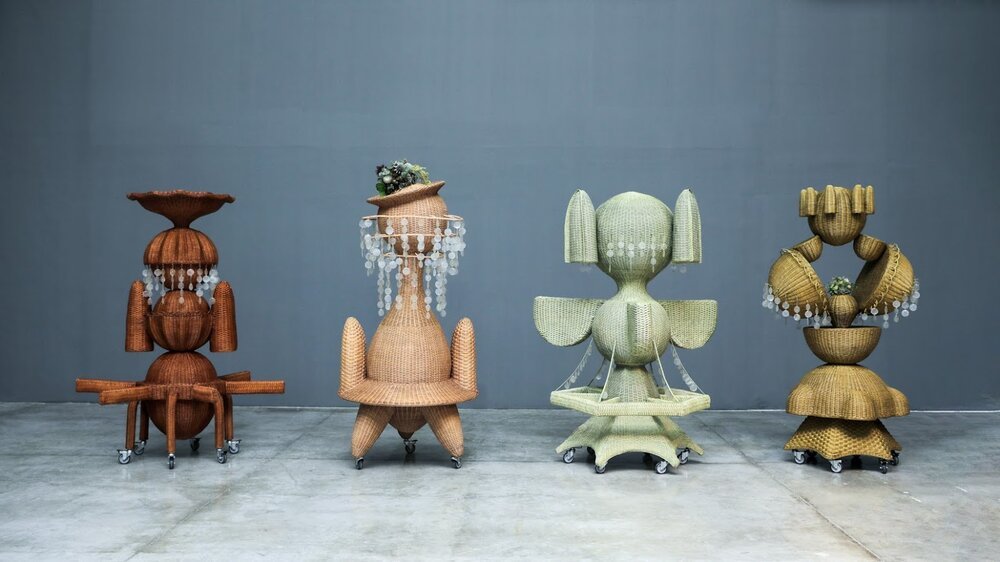Bagyi Aung Soe at Centre Pompidou
Myanmar modern master’s first major exhibition
By Ian Tee
Bagyi Aung Soe, ‘Illustration for “Drunkards'' in Myawadi magazine’, June 1988, felt-tip pen and ink on paper, 18.5 x 27.9cm. nnncl collection.
Centre Pompidou affirms its commitment to exploring plural modernities with ‘Bagyi Aung Soe (1923-1990)’, the Burmese artist’s first major exhibition. Curated by Yin Ker and Catherine David, the exhibition features 88 original artworks and more than 200 documents including printed matter, photographs and manuscripts. It offers an in-depth look into Aung Soe’s unique artistic language and his reflections on modernity. Notably, this is the second solo show by a Southeast Asian artist at the Parisian institution, following a focused presentation of Latiff Mohidin’s ‘Pago Pago’ series in 2018.
‘Bagyi Aung Soe (1923-1990)’, 2021, exhibition view. Image courtesy of Centre Pompidou.
‘Bagyi Aung Soe (1923-1990)’, 2021, exhibition view. Image courtesy of Centre Pompidou.
Taking a chronological approach, the exhibition begins in the 1940s with Aung Soe’s early illustrations in literary magazines. These works won the artist support from the intelligentsia and led to an opportunity to study art at the prestigious Viśva-Bharati University in Bengal, under the Indian Government Scholarship. It was a high-profile apprenticeship under Rabindranath Tagore, who was not only the first non-European to win the Nobel Prize in Literature, but was also responsible for the revival of traditional Indian painting. Even though Aung Soe returned to Yangon after only a year, Tagore’s idea of competing modernisms profoundly shaped the younger artist’s outlook and philosophy.
Archival material, ‘Zen art... for 25 kyats’, 1987 Bagyi Lynn Wunna collection.
Bagyi Aung Soe, ‘Kali’, c. 1986, felt pen, acrylic and gouache on paper. Collection of Gajah Gallery.
Fundamental to this worldview was the notion of modern art as a living tradition which constantly negotiates between the inherited past and the new. In Aung Soe’s words: “My version of ‘new tradition’ is not confined within an area; it has no boundaries. It encompasses not only the traditions unique to a culture, but is derived from any tradition in the world.”
Co-curator Yin Ker notes that Aung Soe’s modernity “lies not in any style or -ism adopted in his painting, but in the incisive consciousness of his place in the expanded world.” Aung Soe’s response to the question of modern Burmese art was his manaw maheikdi dat pangyi, vibrant felt-tip pen and ink drawings on paper that combine imagery and text from across time and geography. It was a playful mode of expression that sought to encompass “all the traditions of the world”, sidestepping dichotomies such as traditional/ modern, western/ indigenous, high/ low. This rejection of dualistic thinking has its roots in Aung Soe’s understanding of Japanese Zen and Himalayan tantra, two schools of thought which are at variance with state-sanctified Theravada Buddhism. Aung Soe’s modernity was an independent state of mind, freed from both Western models of “progress” and nationalist narratives.
“It was a playful mode of expression that sought to encompass “all the traditions of the world”, sidestepping dichotomies such as traditional/ modern, western/ indigenous, high/ low. ”
Bagyi Aung Soe, ‘Self-Portrait’, c. 1985, oil on panel, 59.7 x 47.8cm. National Gallery Singapore Collection.
While Aung Soe’s philosophy and vision extends beyond borders, knowledge and appreciation of his oeuvre has been largely confined to his home country. This impediment is partly due to the stereotypes perpetuated about Myanmar and the tribulations since her independence, as well as the artist’s disinterest in pursuing networks of patronage. The fact that Aung Soe’s work does not conform to conventions of the art world also contributed to his exclusion, as his preferred medium of felt-tip pen on paper commands little currency in the international art market for modern art.
Outside of Myanmar, Gajah Gallery and National Gallery Singapore have the largest private and public collections of his work respectively. Jasdeep Sandhu, Founder of Gajah Gallery, cites the artist as a significant driving force behind his decision to focus on Southeast Asian art history. He says, “Aung Soe’s works, philosophy and writings formed the backbone for the gallery’s inspiration.” More than half of the artworks on view in the Centre Pompidou exhibition are from Gajah Gallery’s collection.
With growing interest in expanding global art history, Ker considers Aung Soe’s work as “a conduit through which the field can emerge on a fresh plane… to hear voices other than the most familiar ones.” Indeed, the exhibition marks one step in the direction of making the institutions of tomorrow more inclusive.
‘Bagyi Aung Soe (1923-1990)’ is on view from 10 February to 23 August 2021, at Centre Pompidou.
For more information about the artist, read Yin Ker’s essay in this e-publication.











